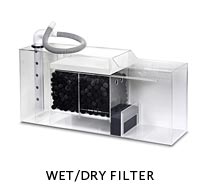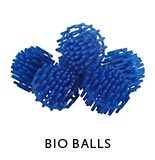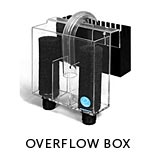Wet/Dry Filters
Wet/Dry Filters are considered to be among the best type of biological filters available for marine aquariums. These filters are also known as trickle filters and can also work for reef tanks and freshwater aquariums. If you have an aquarium ecosystem which has a lot of fish and other livestock, these filters are just going to give the right amount of filtration.
The microorganisms that turn harmful ammonia into better substances need oxygen. This oxygen is what helps them control the toxicity of the aquarium environment and is how they process debris and other waste into something usable and non-toxic. Wet/Dry Filters provide these helpful bacteria with all the oxygen they need. Water trickles through mechanical media which is what causes more oxygen build up which then gets to the bed of useful bacteria. Complete three stage filtration is offered by Wet/Dry Filters.
Sump Style Wet/Dry Filters
 A sump is an external water reservoir and a sump style wet/dry filter is usually installed underneath the aquarium.
This style of filters have always gained more popularity because wet/dry sumps work for just any set up including sensitive reef creatures.
Sumps will increase the stability of the water environment and have the added benefit of increasing the water volume.
These are great for out-of-sight storage of protein skimmers or any other equipment like waters pumps and calcium reactors.
A sump is an external water reservoir and a sump style wet/dry filter is usually installed underneath the aquarium.
This style of filters have always gained more popularity because wet/dry sumps work for just any set up including sensitive reef creatures.
Sumps will increase the stability of the water environment and have the added benefit of increasing the water volume.
These are great for out-of-sight storage of protein skimmers or any other equipment like waters pumps and calcium reactors.
You can easily design a sump from some kind of container or even an old fish tank or purchase one. Essentially a sump is a simple water container which will be on the outside of your aquarium. This sump relies on a siphon overflow system which means it should move water out of the aquarium and push it back up the tank through a water pump once filtration is completed. For different filtration methods, sumps are often divided into chambers. Filter Sumps can be configured like configuring any other sumps. The idea is to have a multi-chambered sump which works for your system. Bio-media filters, Berlin filters and algal filters are two common sumps which are also sometimes used in combinations.
Berlin Filters
These are very good saltwater filters great for reef purists because they are low maintenance and natural. The system is basically made of a live rock pre-colonized with denitrifying bacteria. These microorganisms which may include photosynthetic algae are natural filters for reef systems and when the live rock is placed in the sump it works as a wonderful natural filter. Live rock can be cultured in the ocean reef rock or they can also be porous coral remnants. The major components of a Berlin Filter include Live Rock, Protein Skimmers and Reef appropriate lighting.
Berlin Filters have their pros and cons and limitations of course. For one thing they rely on protein skimmers for mechanical filtration and you will need intense reef lighting. Protein skimmers help in removal of large waste particles which is essential for live rock maintenance and efficiency of Berlin filter. You will also need to keep rock organisms healthy which requires that you provide them compact fluorescent, VHO, T5, or metal halide intense reef lighting.
Other cons of Berlin Filters include space limitation. If you have a large aquarium or one that is filled with more livestock, you will need more rock for waste processing and that amount of live rock may not fit in the sump. Some modern saltwater hobbyists like to forego sump entirely so they can keep live rock in their tanks, but this is possible only if you have lightly stocked tanks. One benefit of this system is that it is a natural process and for captive marine systems this is the best nature-helped filtration option.
Algal Filters
Algal Filters are a natural way to help saltwater aquariums make the most of Wet/Dry filters. While Wet/Dry filters are great at ammonia conversion, when there is a high nitrate build up in heavily stocked aquariums, regular water changes will not suffice. This is especially important for saltwater livestock which happen to be rather delicate and need low nitrate levels to keep breathing. In such a system, where Wet/Dry filters alone will not take care of the problem at hand, Algal Filters can help keep steady low levels of nitrates to reduce toxicity. It is a natural method of acquiring a healthy aquarium ecosystem and algae cultured in refugium sections in sumps can be used as filter methods because algae have a tendency to consume nitrates like other plants. In the ocean there are macroalgae which can also be cultured as strains to resemble seaweed or plants.
Combining algal filters with Berlin filters is going to create a lovely natural environment to produce healthy, low maintenance solution for water filtration. Appropriate lighting is a must for Macroalgae.
Bio Media
 Bio media such as bio balls should only be used in fish only saltwater aquariums and product too much nitrate to be used in reef aquariums.
Clean only a fraction of the bio media at a time using only dechlorinated water.
Using chlorinated tap water will kill the beneficial bacteria living within the bio media causing the aquarium to begin the nitrification process again.
Bio media such as bio balls should only be used in fish only saltwater aquariums and product too much nitrate to be used in reef aquariums.
Clean only a fraction of the bio media at a time using only dechlorinated water.
Using chlorinated tap water will kill the beneficial bacteria living within the bio media causing the aquarium to begin the nitrification process again.
What You Need to Know About Sumps
There might still be a lot of things to figure out when you’ve decided you are going to use sumps. The first and foremost is to take care that the water in aquarium is not siphoned out. Plumbing malfunctions often cause these problems and so can power failures. This is why you cannot plump straight into the water when plumbing sump into the aquarium tank.
Overflow Boxes
 You will need siphon overflow boxes to ensure your piping feeds into and from these boxes.
These overflow boxes can be purchased on their own or there are aquarium tanks available with built in overflow boxes.
Back siphoning is another problem during power failures.
High water levels can cause automatic siphoning and sump can be flooded because when your pump is turned off water cannot flow back to your tank.
You will need siphon overflow boxes to ensure your piping feeds into and from these boxes.
These overflow boxes can be purchased on their own or there are aquarium tanks available with built in overflow boxes.
Back siphoning is another problem during power failures.
High water levels can cause automatic siphoning and sump can be flooded because when your pump is turned off water cannot flow back to your tank.
Pros and Cons of Sumps
Sumps allow you to easily add trace element supplements and keep your equipment out of sight. They increase water volume and it is easy to add new water gradually which helps prevent many problems. Partitioned sumps can help in culturing of live foods include brine shrimps as well as plankton and macroalgae. You can also make use of it as a refugium for fragile or damage organisms. These chambers protect the inhabitants while also providing them the same healthy water conditions that the rest of the tank has. Pre-constructed sumps are actually quite easy to install and use but you can even find DIY sump designs online and create one from old tanks.
Using Wet/Dry Filters Successfully
One of the most effective modern methods of meticulous saltwater aquarium keeping happens to be Berlin filter/algal filter combinations. Adding a protein skimmer to a saltwater wet/dry filter system can be useful because this reduces the load on biological media to keep low ammonia/nitrate levels. Maintaining water levels becomes important in wet/dry filtration systems and you will need to clean them regularly. This ensures there are no overflow accidents and proper flow is always maintained in and out of your system without any filter flow loss. Wet/Dry filters can be very effective for heavily stocked aquariums but they do have some limitations which might be overcome with some amount of effort. With a bit of help, you too can build an effective wet/dry filter system.